musthavedone的反意疑问句答疑
- 格式:doc
- 大小:13.50 KB
- 文档页数:2
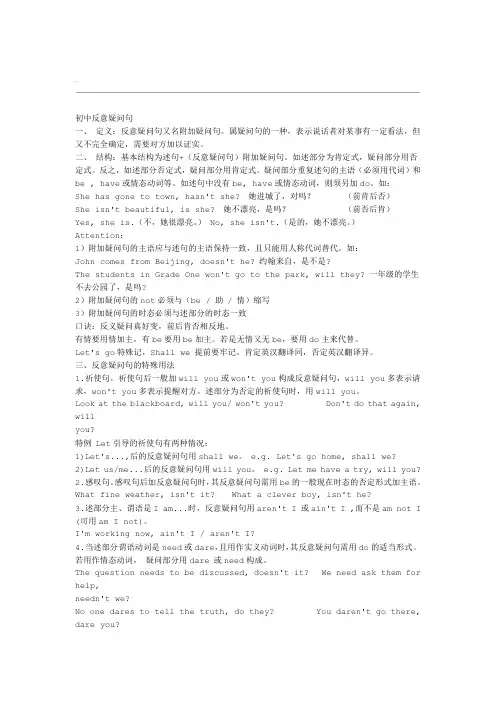
.初中反意疑问句一、定义:反意疑问句又名附加疑问句。
属疑问句的一种,表示说话者对某事有一定看法,但又不完全确定,需要对方加以证实。
二、结构:基本结构为述句+(反意疑问句)附加疑问句。
如述部分为肯定式,疑问部分用否定式。
反之,如述部分否定式,疑问部分用肯定式。
疑问部分重复述句的主语(必须用代词)和be , have或情态动词等。
如述句中没有be, have或情态动词,则须另加do。
如:She has gone to town, hasn't she? 她进城了,对吗?(前肯后否)She isn't beautiful, is she? 她不漂亮,是吗?(前否后肯)Yes, she is.(不,她很漂亮。
) No, she isn't.(是的,她不漂亮。
)Attention:1)附加疑问句的主语应与述句的主语保持一致,且只能用人称代词替代。
如:John comes from Beijing, doesn't he? 约翰来自,是不是?The students in Grade One won't go to the park, will they? 一年级的学生不去公园了,是吗?2)附加疑问句的not必须与(be / 助 / 情)缩写3)附加疑问句的时态必须与述部分的时态一致口诀:反义疑问真好变,前后肯否相反地。
有情要用情加主,有be要用be加主。
若是无情又无be,要用do主来代替。
Let's go特殊记,Shall we 提前要牢记。
肯定英汉翻译同,否定英汉翻译异。
三、反意疑问句的特殊用法1.祈使句。
祈使句后一般加will you或won't you构成反意疑问句,will you多表示请求,won't you多表示提醒对方。
述部分为否定的祈使句时,用will you。
Look at the blackboard, will you/ won't you? Don't do that again, willyou?特例 Let引导的祈使句有两种情况:1)Let's...,后的反意疑问句用shall we。
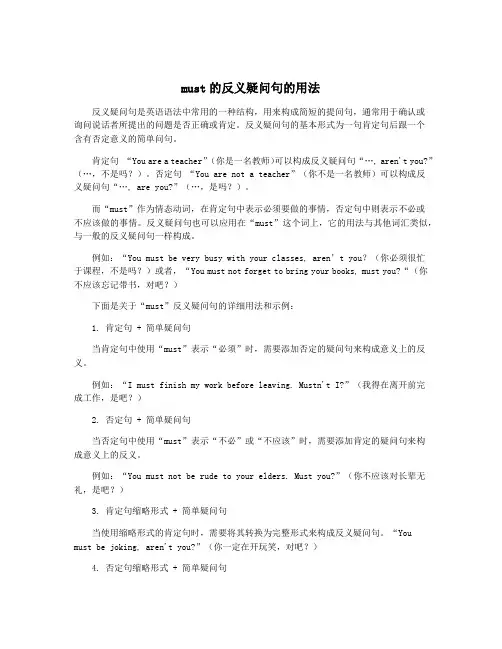
must的反义疑问句的用法反义疑问句是英语语法中常用的一种结构,用来构成简短的提问句,通常用于确认或询问说话者所提出的问题是否正确或肯定。
反义疑问句的基本形式为一句肯定句后跟一个含有否定意义的简单问句。
肯定句“You are a teacher”(你是一名教师)可以构成反义疑问句“…, aren't you?”(…,不是吗?)。
否定句“You are not a teacher”(你不是一名教师)可以构成反义疑问句“…, are you?”(…,是吗?)。
而“must”作为情态动词,在肯定句中表示必须要做的事情,否定句中则表示不必或不应该做的事情。
反义疑问句也可以应用在“must”这个词上,它的用法与其他词汇类似,与一般的反义疑问句一样构成。
例如:“You must be very busy with your classes, aren’t you?(你必须很忙于课程,不是吗?)或者,“You must not forget to bring your books, must you?“(你不应该忘记带书,对吧?)下面是关于“must”反义疑问句的详细用法和示例:1. 肯定句 + 简单疑问句当肯定句中使用“must”表示“必须”时,需要添加否定的疑问句来构成意义上的反义。
例如:“I must finish my work before leaving. Mustn't I?”(我得在离开前完成工作,是吧?)2. 否定句 + 简单疑问句当否定句中使用“must”表示“不必”或“不应该”时,需要添加肯定的疑问句来构成意义上的反义。
例如:“You must not be rude to your elders. Must you?”(你不应该对长辈无礼,是吧?)3. 肯定句缩略形式 + 简单疑问句当使用缩略形式的肯定句时,需要将其转换为完整形式来构成反义疑问句。
“You must be joking, aren't you?”(你一定在开玩笑,对吧?)4. 否定句缩略形式 + 简单疑问句当使用缩略形式的否定句时,需要将其转换为完整形式来构成反义疑问句。
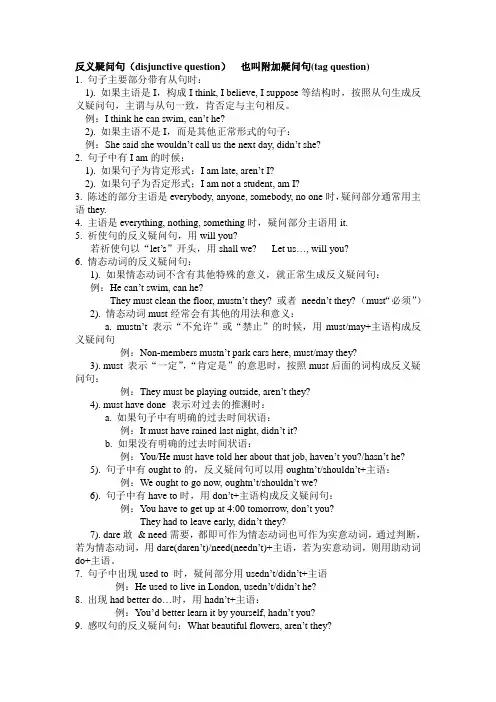
反义疑问句(disjunctive question)也叫附加疑问句(tag question)1. 句子主要部分带有从句时:1). 如果主语是I,构成I think, I believe, I suppose等结构时,按照从句生成反义疑问句,主谓与从句一致,肯否定与主句相反。
例:I think he can swim, can’t he?2). 如果主语不是I,而是其他正常形式的句子:例:She said she wouldn’t call us the next day, didn’t she?2. 句子中有I am的时候:1). 如果句子为肯定形式:I am late, aren’t I?2). 如果句子为否定形式;I am not a student, am I?3. 陈述的部分主语是everybody, anyone, somebody, no one时,疑问部分通常用主语they.4. 主语是everything, nothing, something时,疑问部分主语用it.5. 祈使句的反义疑问句,用will you?若祈使句以“let’s”开头,用shall we? Let us…, will you?6. 情态动词的反义疑问句:1). 如果情态动词不含有其他特殊的意义,就正常生成反义疑问句:例:He can’t swim, can he?They must clean the floor, must n’t they? 或者needn’t they? (must“必须”)2). 情态动词must经常会有其他的用法和意义:a. mustn’t 表示“不允许”或“禁止”的时候,用must/may+主语构成反义疑问句例:Non-members mustn’t park cars here, must/may they?3). must 表示“一定”,“肯定是”的意思时,按照must后面的词构成反义疑问句:例:They must be playing outside, are n’t they?4). must have done 表示对过去的推测时:a. 如果句子中有明确的过去时间状语:例:It must have rained last night, didn’t it?b. 如果没有明确的过去时间状语:例:You/He must have told her about that job, haven’t you?/hasn’t he?5). 句子中有ought to的,反义疑问句可以用oughtn’t/shouldn’t+主语:例:We ought to go now, oughtn’t/shouldn’t we?6). 句子中有have to时,用don’t+主语构成反义疑问句:例:You have to get up at 4:00 tomorrow, don’t you?They had to leave early, didn’t they?7). dare敢& need需要,都即可作为情态动词也可作为实意动词,通过判断,若为情态动词,用dare(daren’t)/need(needn’t)+主语,若为实意动词,则用助动词do+主语。
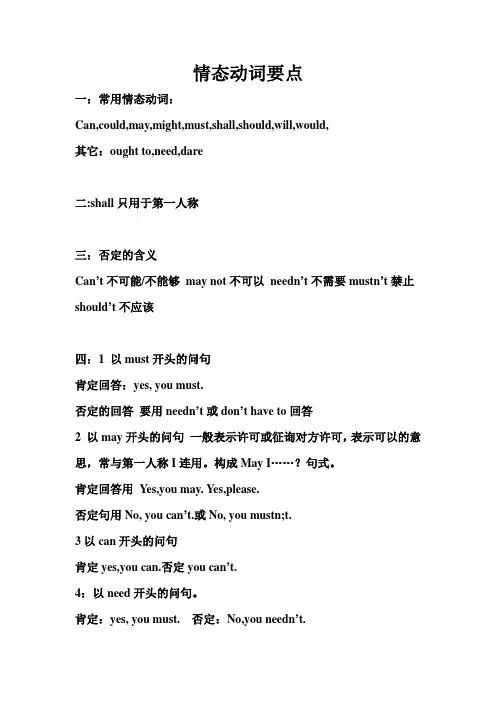
情态动词要点一:常用情态动词:Can,could,may,might,must,shall,should,will,would,其它:ought to,need,dare二:shall只用于第一人称三:否定的含义Can’t不可能/不能够may not不可以needn’t不需要mustn’t禁止should’t不应该四:1 以must开头的问句肯定回答:yes, you must.否定的回答要用needn’t或don’t have to回答2 以may开头的问句一般表示许可或征询对方许可,表示可以的意思,常与第一人称I连用。
构成May I……?句式。
肯定回答用Yes,you may. Yes,please.否定句用No, you can’t.或No, you mustn;t.3以can开头的问句肯定yes,you can.否定you can’t.4:以need开头的问句。
肯定:yes, you must. 否定:No,you needn’t.五:maybe和may be区别Maybe是副词,常做状语,意为也许可能,相当于perhaps位于句首。
May be是一个情态动词加动词原型的用法,是一个完整的谓语形式,意为可能是……也许是……例如:Maybe he is a teacher.=He may be a teacher.Maybe you are right=You may be right.六:must和have to区别Must是必须干什么,比较主观的要求命令Have to 是由于客观的原因不得不七:could只在问句中表示温婉礼貌请求,是一般现在时,回答要用can.八:need1:做实意动词是需要的意思,有人称和数的变化,通常在肯定句中2:做情态动词后接动词原型,通常在否定句和疑问句中。
反义疑问句要点一:定义:反义疑问句是由陈述句和附在后面的附加疑问句组成。
前否后肯,前肯后否。
二:附加疑问句的主语要用相应代词。
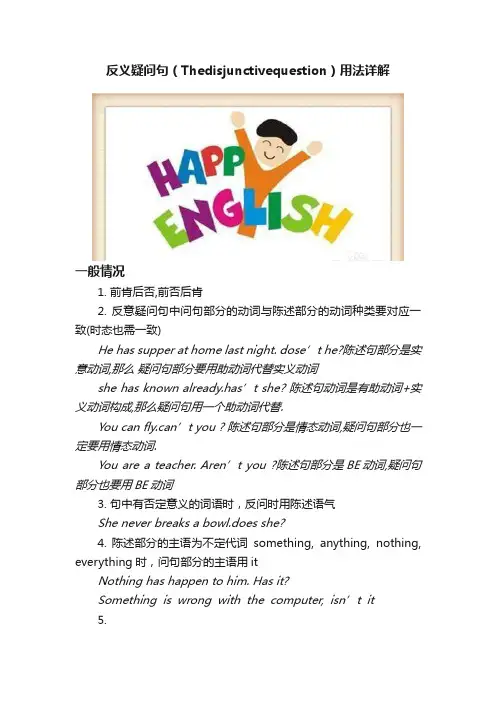
反义疑问句(Thedisjunctivequestion)用法详解一般情况1. 前肯后否,前否后肯2. 反意疑问句中问句部分的动词与陈述部分的动词种类要对应一致(时态也需一致)He has supper at home last night. dose’t he?陈述句部分是实意动词,那么疑问句部分要用助动词代替实义动词she has known already.has’t she? 陈述句动词是有助动词+实义动词构成,那么疑问句用一个助动词代替.You can fly.can’t you ? 陈述句部分是情态动词,疑问句部分也一定要用情态动词.You are a teacher. Aren’t you ?陈述句部分是BE动词,疑问句部分也要用BE动词3. 句中有否定意义的词语时,反问时用陈述语气She never breaks a bowl.does she?4. 陈述部分的主语为不定代词something, anything, nothing, everything时,问句部分的主语用itNothing has happen to him. Has it?Something is wrong with the computer, isn’t it5.somebody(someone),anybody(anyone),nobody(noone),everybo dy(everyone)时,问句部分的主语用he或they,这时问句动词的数应和he或they一致Someone has taken the seat,hasn’t he?Everyone has done their best to overcome the issue.haven’t they?祈使句的反义疑问句6. 祈使句的陈述句有三种反问法will you请你/would you请您/won’t you好吗?(语气自己好好体会体会)Please open the door. will you/would you/ won’t you?7. 祈使句的否定句一般只用will you?Don,t tell anybody. Will you ?8.陈述部分为Let me……时,问句部分习惯上用shall I? 或will you?形式。
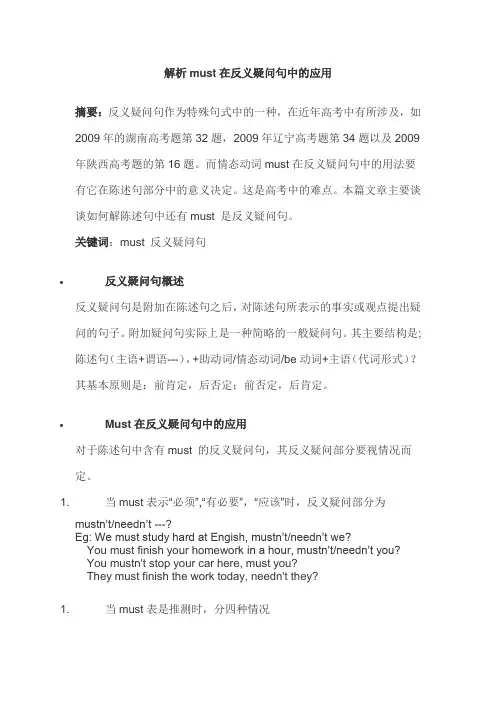
解析must在反义疑问句中的应用摘要:反义疑问句作为特殊句式中的一种,在近年高考中有所涉及,如2009年的湖南高考题第32题,2009年辽宁高考题第34题以及2009年陕西高考题的第16题。
而情态动词must在反义疑问句中的用法要有它在陈述句部分中的意义决定。
这是高考中的难点。
本篇文章主要谈谈如何解陈述句中还有must 是反义疑问句。
关键词:must 反义疑问句∙反义疑问句概述反义疑问句是附加在陈述句之后,对陈述句所表示的事实或观点提出疑问的句子。
附加疑问句实际上是一种简略的一般疑问句。
其主要结构是;陈述句(主语+谓语---),+助动词/情态动词/be动词+主语(代词形式)?其基本原则是:前肯定,后否定;前否定,后肯定。
∙Must在反义疑问句中的应用对于陈述句中含有must 的反义疑问句,其反义疑问部分要视情况而定。
1. 当must表示“必须”,“有必要”,“应该”时,反义疑问部分为mustn’t/needn’t ---?Eg: We must study hard at Engish, mustn’t/needn’t we?You must finish your homewo rk in a hour, mustn’t/needn’t you?You mustn't stop your car here, must you?They must finish the work today, needn't they?1. 当must表是推测时,分四种情况1. 对现在情况的推测,反义疑问部分与must后面的动词相呼应:是be动词,反义疑问部分用isn’t/aren’t---?是实义动词用don’t/doesn’t---?Eg: you must be joking, a ren’t you?He must be ill, isn’t he?You must know the answer to the exercise, don't you?(2)对过去动作的推测,此时must的表现形式为must have done,a). 单纯表示对过去的推测(一般句中有明确的过去时间状语),与现在无关, 反意疑问句附加部分“didn't---?”。
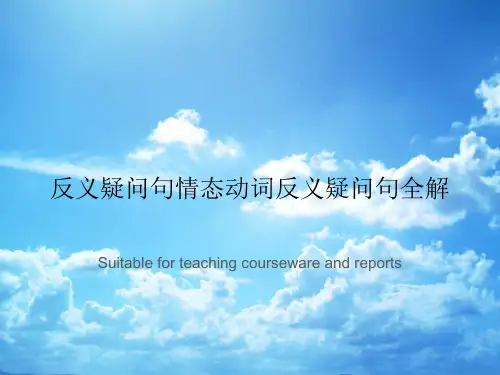
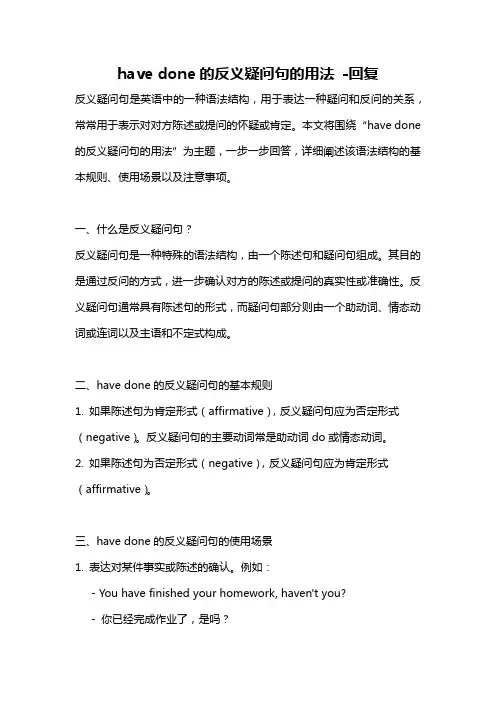
have done的反义疑问句的用法-回复反义疑问句是英语中的一种语法结构,用于表达一种疑问和反问的关系,常常用于表示对对方陈述或提问的怀疑或肯定。
本文将围绕“have done 的反义疑问句的用法”为主题,一步一步回答,详细阐述该语法结构的基本规则、使用场景以及注意事项。
一、什么是反义疑问句?反义疑问句是一种特殊的语法结构,由一个陈述句和疑问句组成。
其目的是通过反问的方式,进一步确认对方的陈述或提问的真实性或准确性。
反义疑问句通常具有陈述句的形式,而疑问句部分则由一个助动词、情态动词或连词以及主语和不定式构成。
二、have done的反义疑问句的基本规则1. 如果陈述句为肯定形式(affirmative),反义疑问句应为否定形式(negative)。
反义疑问句的主要动词常是助动词do或情态动词。
2. 如果陈述句为否定形式(negative),反义疑问句应为肯定形式(affirmative)。
三、have done的反义疑问句的使用场景1. 表达对某件事实或陈述的确认。
例如:- You have finished your homework, haven't you?- 你已经完成作业了,是吗?- No, I haven't.- 不对,我还没有完成。
2. 表示请求对方确认自己所说的内容。
例如:- You haven't seen her, have you?- 你没有见过她,是吗?- Yes, I have.- 是的,我见过。
3. 用于宾语从句中,表示对所述内容的再次确认。
例如:- She said you have been to Paris, haven't you?- 她说你去过巴黎,对吗?- No, I haven't been to Paris.- 不对,我没有去过巴黎。
四、have done的反义疑问句的注意事项1. 在反义疑问句中,主语的人称和数要与陈述句中的主语保持一致。
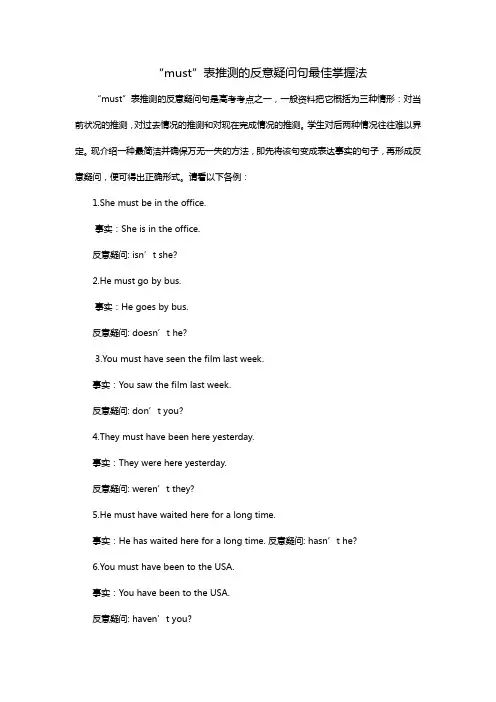
“must”表推测的反意疑问句最佳掌握法“must”表推测的反意疑问句是高考考点之一,一般资料把它概括为三种情形:对当前状况的推测,对过去情况的推测和对现在完成情况的推测。
学生对后两种情况往往难以界定。
现介绍一种最简洁并确保万无一失的方法,即先将该句变成表达事实的句子,再形成反意疑问,便可得出正确形式。
请看以下各例:
1.She must be in the office.
事实:She is in the office.
反意疑问: isn’t she?
2.He must go by bus.
事实:He goes by bus.
反意疑问: doesn’t he?
3.You must have seen the film last week.
事实:You saw the film last week.
反意疑问: don’t you?
4.They must have been here yesterday.
事实:They were here yesterday.
反意疑问: weren’t they?
5.He must have waited here for a long time.
事实:He has waited here for a long time. 反意疑问: hasn’t he?
6.You must have been to the USA.
事实:You have been to the USA.
反意疑问: haven’t you?。
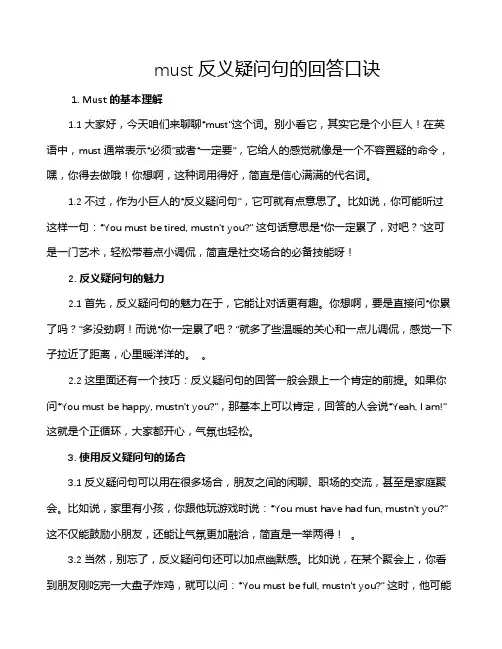
must反义疑问句的回答口诀1. Must的基本理解1.1 大家好,今天咱们来聊聊“must”这个词。
别小看它,其实它是个小巨人!在英语中,must通常表示“必须”或者“一定要”,它给人的感觉就像是一个不容置疑的命令,嘿,你得去做哦!你想啊,这种词用得好,简直是信心满满的代名词。
1.2 不过,作为小巨人的“反义疑问句”,它可就有点意思了。
比如说,你可能听过这样一句:“You must be tired, mustn't you?” 这句话意思是“你一定累了,对吧?”这可是一门艺术,轻松带着点小调侃,简直是社交场合的必备技能呀!2. 反义疑问句的魅力2.1 首先,反义疑问句的魅力在于,它能让对话更有趣。
你想啊,要是直接问“你累了吗?”多没劲啊!而说“你一定累了吧?”就多了些温暖的关心和一点儿调侃,感觉一下子拉近了距离,心里暖洋洋的。
2.2 这里面还有一个技巧:反义疑问句的回答一般会跟上一个肯定的前提。
如果你问“You must be happy, mustn't you?”,那基本上可以肯定,回答的人会说“Yeah, I am!” 这就是个正循环,大家都开心,气氛也轻松。
3. 使用反义疑问句的场合3.1 反义疑问句可以用在很多场合,朋友之间的闲聊、职场的交流,甚至是家庭聚会。
比如说,家里有小孩,你跟他玩游戏时说:“You must have had fun, mustn't you?” 这不仅能鼓励小朋友,还能让气氛更加融洽,简直是一举两得!。
3.2 当然,别忘了,反义疑问句还可以加点幽默感。
比如说,在某个聚会上,你看到朋友刚吃完一大盘子炸鸡,就可以问:“You must be full, mustn't you?”这时,他可能会哈哈大笑,心里想“哪里够呢?我还想再来一盘!”这种小互动,总是让人觉得暖心又有趣。
4. 如何正确使用反义疑问句4.1 说了这么多,咱们再来看看怎么正确使用反义疑问句。
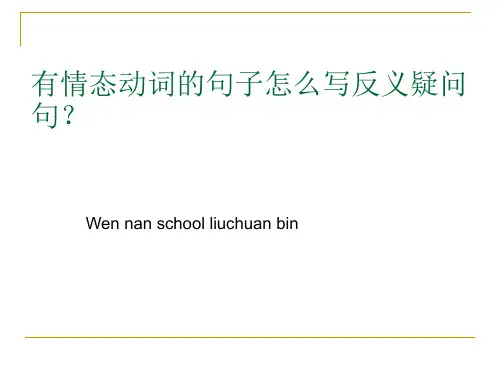
初中英语反义疑问句的用法归纳反义疑问句是由两部分组成的,前一部分是对事物的陈述,后一部分是简短的提问,中间用逗号隔开。
想知道初中英语反义疑问句怎么用吗?一起来看看吧,以下是店铺分享给大家的初中英语反义疑问句的用法,希望可以帮到你!初中英语反义疑问句的用法1. 当陈述部分的主语是I,而句子又是用来征询对方的意见时,附加疑问句中的主语用you。
如:I find English very interesting, don't you?I don't like that film, do you?2. 当陈述部分的主语是everybody, everyone, someone, nobody, no one, somebody等合成代词时,附加疑问句中的主语通常用they。
但亦可用he,尤其是nobody, no one等作主语,具有表示否定意义时。
如:Somebody phoned while I was out, didn't they?Everyone enjoyed the party, didn't they?Nobody wants to go there, does he?3. 当陈述部分的主语是不定代词everything, nothing, anything, something时,附加疑问句中的主语一般用it,不用they。
如:Everything seems all right now, doesn't it?Nothing is kept in good order, is it?Something must be done to stop pollution, isn't it?4. 当陈述部分的主语是指示代词this, that或these, those时,附加疑问句中的主语分别用it和they。
如:This is important, isn't it?That isn't correct, is it?These are your friends Tom and Jack, aren't they?5. 如果陈述部分是以代词one作主语,附加疑问句中的主语在正式场合用one,非正式场合用you, 在美国英语中,在非正式场合还可以用he。
must在反义疑问句中的用法好啦,今天咱们来聊聊“must”在反义疑问句中的用法。
反义疑问句,听起来就有点拗口,但其实挺简单的。
想象一下,你在和朋友聊天,突然冒出一句:“你肯定得去参加那个派对,必须的,对吧?”这句子就用到了“must”,而且用了反义疑问句的形式。
你可以感受到那种期待,真心希望对方也认同你的观点。
咱们得明白“must”这个词的意思。
它通常表示一种强烈的建议、必要性或者是肯定的推测。
比如说,看到朋友半夜还在加班,你就会说:“你必须早点回家休息啊!”这不是开玩笑,而是关心。
这时候,若你加上反义疑问句,就变得有趣多了。
你可以接着问:“你必须早点回家休息啊,不能不回吧?”这下就让对方有机会表达自己的看法了。
反义疑问句的魅力就在于它能让对话更有互动性。
你发出一个强烈的建议,然后再用反义疑问句给对方一个发言的机会。
就像在打乒乓球,你发球,对方接球,这样的对话就生动多了。
想象一下,你跟朋友讨论周末的计划:“我们周末肯定得去爬山,必须得去,难道不是吗?”这里的“难道不是吗”就是反义疑问句,让对方也参与进来。
可能他会说:“当然可以啊,不过我更想去海边。
”这一下就把话题推向了另一个方向。
有趣的是,反义疑问句常常能透露出说话者的态度。
比如说,如果你说:“你一定得试试这个新餐厅,真不错,得吧?”听起来就很兴奋,像是在给对方安利。
如果你说:“你必须得试试这个新餐厅,不然你会后悔的,对吗?”这就带了一点小小的威胁,仿佛不试就会错过什么大事一样。
咱们再看看不同场合下的用法。
想象你跟朋友在逛街,你看中了一件衣服:“这件衣服看起来真不错,你得买,必须的,对吧?”这时候,反义疑问句不仅能让你表达自己对衣服的喜欢,也能引导对方的选择。
毕竟,大家都喜欢被支持和鼓励。
反义疑问句还能带出一种玩笑的语气。
比如,你和朋友一起看电影,看到一个老掉牙的剧情,你就可以说:“这个剧情真是烂透了,肯定得让人笑死,不是吗?”这时候,你的语气是轻松的,带着调侃的意味,显得亲切又幽默。
情态动词+动词完成时,即情态动词+have+done.表示对过去的行为或动作进行推测,评论或者判断.
1. must have done.
表示对过去某事的肯定猜测,其否定或疑问形式都用can/could来表示。
例如:Since the road is wet, it must have rained last night.
2;当然对现在发生或者将来发生的事情,要用must do表示猜测,否定为can’t do He must understand that we mean business.
You must be hungry after a long walk.
反意疑问句中含有Must的情况主要有以下几种:
1)作为情态动词表“必须”,这时反意疑问句直接用mustn’t/needn't
2)当must表示推测时又分以下几种情况:
a:对现在事实的推测,反意疑问句与must后面的动词呼应,如:
You must be joking, aren’t you
b:对过去事实的推测,表示动作的时候用did 当助动词,表示状态时用was,如:Mr Green must have been punished for his being rude at the meeting,didn‘t he (格林先生一定因为昨天在会上鲁莽的行为被处罚了,是吗)被处罚表示一个动作She must have been a policeman ,wasn't she (她过去一定是个警察,是吗)是警察表示一种状态
对现在情况的推测,问句部分用主动词(do, be)一般现在时的适当形式。
若是现在进行时,问句部分用现在进行时的适当形式表示。
若是there be结构,问句用isn't/aren't there。
如:
1)He must be there, isn’t he
2)He must have a big family, doesn’t he
3)He must be waiting outside, isn’t he
4)There must be some students in the room, aren’t there
对已发生的过去情况的推测,若陈述句谓语部分有“must have done”,而且有表示过去的时间状语,问句部分用didn't;若没有表示过去的时间状语,问句部分用haven't或hasn't。
如:
1)They must have gone there last night, didn’t they
2)They must have arrived by now, haven’t they(根据by now来判断)
3)They must have been to the Great Wall, haven’t they
若是被动,应按被动结构来处理。
如:
1)The room must have been cleaned yesterday, was n’t it
2)The room must have been cleaned, hasn’t it
若句中有表示过去完成时的时间状语,问句部分应用hadn't.如:
They must have learnt 5000 English words by the end of last term, hadn’t they
(本题中must表推测,如果将它去掉,还原为真实句就是They had learnt 5000 English words by the end of last term.因此,反意问句是hadn't)。